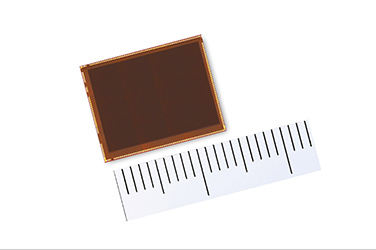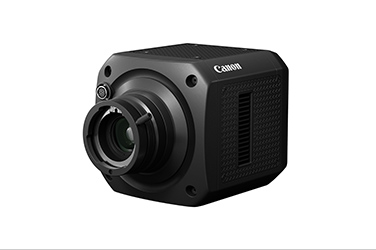

A Breakthrough That Expands the Possibilities of Terahertz Waves
A Semiconductor Terahertz Source
Terahertz waves have sparked much interest in the potential they hold for 6G wireless transmission and next-generation sensing technologies. At the same time, emitting these waves has required large and expensive equipment, which was an issue. In this environment, Canon has successfully developed a highly anticipated compact semiconductor device capable of transmitting a high output power level of terahertz waves. This device is gaining attraction as a tremendous breakthrough toward the spread of terahertz waves that will change the future of society.
February 7, 2024
Terahertz waves: Unlike X-rays, are radiation-safe with the properties of both radio and light waves
Our lives are intimately intertwined with various types of waves. Visible light is one of them and there are also other types of invisible waves such as ultraviolet light, X-rays, and even the radio waves used for communications. All of these are collectively referred to as “electromagnetic waves.”Electromagnetic waves vary greatly according to wavelength (the distance between the two peaks or valleys of waves) or frequency*1. For example, what we know as “radio waves” have a longer wavelength (= lower frequency) than visible light, which enables them to travel long distances while easily curving around buildings and other obstructions. They are therefore used in communications such as television broadcasting and mobile phone transmissions. On the other hand, waves with a shorter wavelength (= higher frequency) than visible light, such as ultraviolet light, X-rays, and gamma rays, are high-energy and have high straightness, properties that are widely harnessed for uses such as in medical equipment.

Types of electromagnetic waves according to wavelength and frequency
In recent years, much attention has fallen on a relatively unexplored field of electromagnetic waves: terahertz waves. These have a wavelength and frequency between radio waves and light. With their frequency of nearly 1 terahertz (THz)*2, their permeability allows them to pass through materials like cloth, paper, wood, ceramic, and plastic, much like radio waves, while being reflected by metals and absorbed by water. At the same time, like light, they possess high straightness. This also means that they could form images if shone on a person or object and the reflected or penetrated waves were captured by a camera. As the frequency of terahertz waves that are absorbed is determined according to each substance, they can also be used to identify the constituents of the substance. These characteristics can be used in various applications, such as in non-destructive tests like automobile paint thickness measurements and drug quality inspections. Another potential application is in security checks in places with heavy human traffic, where the waves’ ability to penetrate clothing without exposing the human body to radiation, which had been an issue with X-rays, will be useful.
- *1 Frequency and wavelength have an inverse relationship, wherein Frequency × Wavelength = Speed of Light (= approximately 300,000km per second)
- *2 “Terahertz waves” refers to electromagnetic waves with a frequency of 0.1THz to 10THz (approximately 3mm to 0.03mm when converted to wavelength)
*Silent Video
*In order to view videos, it is necessary to consent to the use of cookies by our website. If the videos are not displayed, please click the "Cookie Settings" and accept cookies.
Characteristics of terahertz waves
Permeability similar to radio waves |
Since a terahertz wave passes through material such as paper, plastic, ceramic, wood, and fibers, it can be used for non-destructive analysis of the internal structure of objects. |
Straightness similar to light |
As it possesses the ability to move in a straight line like a laser beam, it can be used for imaging when directed onto an object being measured and the reflected or penetrated waves are captured with a camera. |
Substance identification |
As the frequency of terahertz waves that are absorbed is determined according to each substance, knowing which wavelengths were absorbed will make it possible to identify the constituents of the material. |
Safety |
Compared to radioactive rays such as X-rays, it has an extremely low amount of energy (0.000001 that of X-rays), so there is no danger of radiation damage to the human body. |
Despite high expectations, a weak light source presents a hurdle to implementation
Terahertz waves also hold great promise for the next generation of wireless communications. The wave range (frequency band) used in today’s latest 5G communication standards are millimeter waves and microwaves that range from 600 megahertz (MHz) to 60 gigahertz (GHz). As terahertz waves have a higher frequency than this range (= more waves per second), they can potentially transmit more data at a higher speed and have started to be considered as a new 6G standard that uses terahertz waves with a frequency band of around 300 GHz.
However, there is one major reason terahertz waves held “unexplored potential” for so long: harnessing them requires a large installation that involves vacuum tubes and frequency multipliers* and costs hundreds of thousands of dollars. Developers have strived to develop a smaller semiconductor device that could be used at normal temperature, which would enable terahertz waves to be used more easily. However, there were still extensive issues such as output power, directivity, and radiation efficiency that needed to be resolved, so using terahertz waves in communications was a distant dream.
- *A device for multiplying frequency by an integer
Approx. 10x the output power with approx. 1/1000 volume
Transmitting terahertz waves requires oscillators that generate the high frequency waves and antennas to radiate them. Until Canon developed its device, a frequency multiplier, amplifier to increase output power, and horn antennas and lenses to control the direction of radiation were also necessary. These issues stood in the way of realizing a compact source.
Canon’s semiconductor terahertz source provided a comprehensive solution to these issues. As a company that pursues many forms of imaging, Canon has been researching and developing terahertz imaging technologies for over 20 years. It had devoted many resources to one particular component: Resonant-Tunneling Diodes (RTD), which showed promise as a compact semiconductor source capable of operating at room temperature but at the same time faced issues with output power and efficiency. In the R&D process, Canon accumulated technologies including the design for an RTD oscillator, a terahertz antenna structure, and compound semiconductor components to go ahead with the development based on an assumption that synchronizing many antennas would collectively make a practicable high-power terahertz source smaller than ever before, even if the output power from each antenna were small.
Their efforts paid off. In 2022, Canon successfully achieved synchronization and coherent oscillation of 36 active antennas* integrated on a semiconductor chip. The output power was 11.8mW, 10 times more than any other existing semiconductor light source. Whereas previous equipment had difficulty achieving an emission angle smaller than 60 degrees, Canon’s new device achieved much higher directivity of 13 degrees without the aid of lenses or other optical technology. Power efficiency was 1.4 times that of existing equipment, while the volume of new equipment was 1/1000—a major breakthrough.

The semiconductor terahertz source developed by Canon
- *An antenna that integrates antenna elements with active electronic components

1000x smaller than existing transmitters
A breakthrough made possible by advanced manufacturing technology
RTDs comprise a plurality of thin film layers having different thicknesses formed on a semiconductor substrate. Instead of widely used silicon, the substrate Canon used was indium phosphide (InP), a compound semiconductor with high electron mobility. By harnessing semiconductor device design technology and semiconductor thin film manufacturing technology, through repeated trial production, Canon’s engineers found the optimal layer structure for high output power. They also invented a proprietary antenna structure in which RTDs and antennas could be integrated onto the substrate surface, reducing terahertz wave loss. These methods resulted in greatly improved emission efficiency.

36 patch (flat) antennas are arranged in a 6x6 array on a semiconductor chip that measures 3.2mm on each edge. Each antenna consists of two RTDs.
Increasing the output power to a level that enables terahertz imaging requires at least 36 antennas (in 6x6 rows). Canon poured effort into researching and developing array layout*1 and phase synchronization*2 methods for each antenna. It was extremely challenging to minimize variation among as many as 36 antennas. However, Canon was able to leverage its antenna design technology and manufacturing technology, including semiconductor microfabrication cultivated through the manufacture of CMOS image sensors, achieving phase synchronization as precise as one-picosecond orders (1 picosecond = 1 trillionth of a second). These technologies enabled an improvement in emission directionality to 13 degrees without lenses or horn antennas. Thus, Canon successfully created a semiconductor terahertz source capable of generating clear images and footage from as far as 10m away.
- *1 An array refers to several antenna elements arranged in rows and columns.
- *2 The phase of a wave is the state of wave oscillation observed at a certain location. In the cyclic pattern of waves, points in the same state are said to be in the same phase.


Output power can be increased by synchronizing waves of the same frequency waves in the same phase. Conversely, unsynchronized waves will cause interference that reduces output power.

An illustration of terahertz wave radiation achieved by 36 synchronized antennas
Synchronizing 36 antennas, the device achieves approximately 10 times more output and 20 times better directivity than existing semiconductor terahertz sources. It does not require bulky horn antennas and lenses.
An array with many antennas usually suffers from reduced output power due to parasitic oscillation. However, Canon’s knowledge of circuit design acquired through its experience developing multiple semiconductor devices enabled it to develop a proprietary high frequency filter that efficiently reduces parasitic oscillation at low frequencies, which have a major impact, to maximize output power. This also improves power efficiency.
A huge step towards unlocking the potential of uncharted territory
The technology behind Canon’s terahertz device has enabled a terahertz source unlike anything seen before. Canon is now developing proposals that will contribute to the evolution of fluoroscopic imaging, including applications for body scanners to inspect prohibited materials and for non-destructive materials analysis, which are predicted to undergo major changes as a result of this technology. As part of these efforts, Canon engineers have created a prototype terahertz camera that capture terahertz waves using lenses and semiconductor sensors and are currently trialing the possibility of using the waves to capture highly practical images and videos, although the resolving capability of terahertz waves pales in comparison to visible light. One demonstration shows that “terahertz imaging” can detect hidden guns and knives on pedestrians.

The creation of a compact, high-output power terahertz source promises to socially accelerate research and development into next-generation sensing and wireless communication technologies. Canon’s development efforts will not stop at the current 450GHz device. Rather, it will continue to develop transmitting and receiving technologies across various frequency ranges, with the aim of increasing more possibilities through terahertz waves.
*Silent Video
*In order to view videos, it is necessary to consent to the use of cookies by our website. If the videos are not displayed, please click the "Cookie Settings" and accept cookies.




